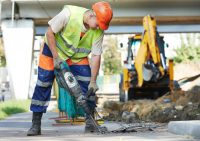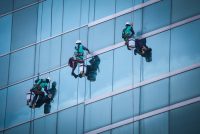Modern safety management goes beyond covering traditional workplace accidents to now being equally concerned with illnesses caused on and even off the job. This section will explain what you need to know to avoid both injuries and illnesses, and to track your progress in reaching this goal.
Free Special REport: Does Your PPE Program Meet OSHA’s Requirements?
Ever hear of the “industrial athlete”? The concept is that employees, like athletes, perform better when they are properly trained and fit for duty. Proponents say that the right training leads to fewer injuries, quicker return to work, and reduced costs. Keep reading to decide whether your workplace would benefit from an on-site athletic trainer. […]
Overexertion, slips, trips, and falls cause 60 percent of lost-time occupational injuries in the United States and cost employers over $30 billion in direct workers’ compensation costs in 2013. One strategy you can use to control these costly injuries is an effective worksite stretching program. The aging workforce is one factor that increases the likelihood […]
When you have a predictable number of workers in a specific location for a predetermined length of time, figuring out how many toilets you have to provide, and your policy on restroom breaks and access (if you even need one), is probably straightforward. But what about mobile work crews? And what of construction and agriculture […]
It’s one of the most basic public health and sanitation measures: the toilet facility. It’s also one of the most basic human needs: the need to eliminate. Despite this, restroom availability and use have been a persistent sticking point between employers and their workers—one with implications for worker health and safety. As such, the availability […]
Manuel Aquino, 70 years old, had worked for Art’s Equipment Rental in Sharonville, Ohio, for 13 years. His job duties included keeping the equipment clean, so on March 3, Aquino was pressure-washing a front-end loader in his employer’s yard. Something went wrong, and Aquino was crushed between the bucket on the loader and the body […]
As with most labor-saving devices, nail guns decrease the amount of labor while increasing risk. The tool’s ability to fire several nails per second at a velocity of more than 1,000 feet per second presents obvious hazards.
Same-level slips, trips, and falls are occupational hazards that can be found in almost every type of work setting. When considering workplace falls, most people immediately think of falls from a height, yet, according to the Bureau of Labor Statistics (BLS), the majority of fall-related injuries occur as a result of falls from same-level walking […]
Pneumatic power tools such as nail guns, chippers, drills, hammers, and sanders are found not only in the workplace but also in the hands of many consumers—and not all of them are construction workers who use those tools during their day jobs and receive appropriate training. Make sure that not only your tradesmen but also […]
In the fall of 2014, OSHA inspected a manufacturer of rice cakes and other healthy snack products after a worker suffered an electrical injury in August 2014. While OSHA was on-site, the Agency discovered that another worker had missed 20 days of work and spent another 22 days on restricted duty after part of his […]
Some jobs are just more dangerous than others. It’s fairly obvious, of course, that steelworkers face greater hazards than office workers—but some hazardous jobs might be less obvious. Are your workers in a high-risk occupation? Here’s what the Bureau of Labor Statistics (BLS) has to say about what industries and occupations pose the deadliest hazards.










